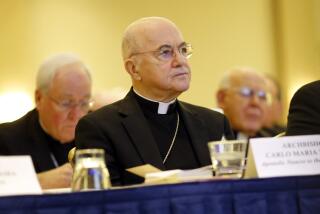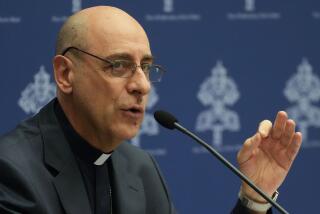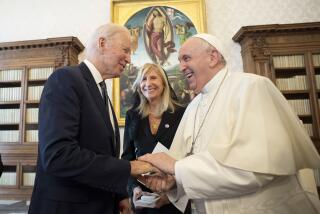Consequences of the Catholic Church’s claim of statehood
Giuseppe dalla Torre, a top Vatican legal advisor, declared in a preemptive strike last week that Pope Benedict XVI could not be sued in an American court. His statement -- in response to allegations that the pope played a role in covering up, among other scandals, the sexual abuse of children at a Wisconsin school for the deaf -- was unequivocal. “The pope is certainly a head of state, who has the same juridical status as all heads of state,” Dalla Torre said, which grants him immunity from foreign courts.
But is the spiritual leader of the world’s Roman Catholics really a “head of state” as well?
Benedict XVI is the head the church’s governing body -- known as the Holy See -- which claims many of the privileges of a sovereign country. In recent decades the Holy See has welcomed ambassadors, signed international treaties and used its status to influence developments at the United Nations.
That the Holy See is often treated as a state is deeply troubling, for several reasons. For one thing, the Catholic Church isn’t truly a sovereign nation; to allow it to play one on the international stage perverts the meaning of statehood.
Moreover, the church’s claim to statehood gives it even more political influence than it would otherwise wield and grants outsized power to only one of the world’s many religions. And its claim is particularly worrisome now that the church -- embroiled in a disturbing scandal that has reached from Boston to Berlin -- is claiming the sort of immunity enjoyed by prime ministers and presidents.
How did this situation come about? The concept of sovereign statehood first developed in 17th century Europe, where the church was long treated as a quasi-state by Western powers. The Papal States existed within Italy for centuries. At their height, the Papal States comprised most of central Italy and parts of what is now southern France.
But the church’s territorial holdings were lost in battles over time, and by the end of the 19th century the church was essentially landless. Then, in the late 1920s, Vatican City was carved out of Rome via a treaty with Italy. The Holy See and Vatican City are legally distinct, but Vatican City was created to give the Holy See a territorial home and thereby safeguard its independence.
Despite opposition from many quarters, the Reagan administration initiated formal diplomatic relations with the Holy See in the 1980s. Today, nearly every country maintains diplomatic ties, and the Holy See is a “permanent observer state” at the U.N. This persists despite its lack of most of the key legal characteristics of statehood.
It’s true that Vatican City runs a popular post office and mints its own currency. But international law requires that a “state” have four attributes: territory, a permanent population, a functioning government and the ability to engage in international relations. The last requirement largely builds on the others: Whether a state can engage in international relations is decided by whether other states treat it like one.
As to the question of territory, there exists only the small parcel of land known as Vatican City. But as any visitor knows, Vatican City is in the middle of Rome and is little more than half the size of the Mall in Washington, D.C. In any event, the Holy See continues to claim that its international status is based on its religious authority, not its territorial enclave.
To say that Vatican City possesses a permanent population of the sort envisioned by international law is even more of a stretch. Most residents are simply members of the church hierarchy, a body composed solely of men. They number less than the student bodies of many high schools -- about 800. As to the Catholics of the world, they are already represented by the governments of other nations.
Vatican City does have a functioning bureaucracy, and so has a government of sorts. Yet it is surely the most unusual government of the world, given its minute size and lack of any standard government functions, such as the administration of justice, education of the young or provision of defense. It even relies on Italy for its water, police and firefighting services.
For decades the strange practice of treating the Catholic Church as a state has been bad for women’s equality, gay rights and reproductive freedom. The Holy See’s fictive statehood allows it to promote its retrograde views on gender and sex in diplomatic settings and during treaty negotiations.
Now, the unfolding sexual abuse scandal reveals another dark side of the Holy See’s claim to statehood: the extraordinary immunities claimed by the pope in the face of conspiracy accusations that span the globe.
Pope Benedict XVI’s predecessor, John Paul II, recognized the tenuous claim to statehood. When Vladimir Putin visited Vatican City some years ago, he offered to invite the pope to Russia. Russian Orthodox leaders opposed the pontiff’s visit, seeing it as an encroachment by Rome on their turf. Putin proposed a solution. As Putin later recalled, he told the pope: “I am ready to invite you as the head of state. I, as the head of state, invite you as the head of state.” The pope replied, “Look out the window. What kind of state do I have here? You can see my whole state right from this window.”
Kal Raustiala is professor of law and director of the Burkle Center for International Relations at UCLA. Lara Stemple is director of graduate studies at UCLA Law School.
More to Read
Sign up for Essential California
The most important California stories and recommendations in your inbox every morning.
You may occasionally receive promotional content from the Los Angeles Times.










